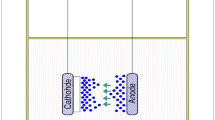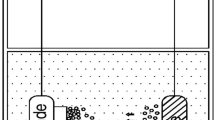Abstract
Attributing to its exceptional heat transfer coefficient (HTC), pool boiling heat transfer is one of the most popular heat transfer mechanisms for dissipating a large amount of heat on a smaller cooling space for achieving the cooling in the electronic devices. The main effort of this study is to provide an experimental observation on pool boiling heat transfer on Cu-plain surfaces by applying microporous coating surface layers having thickness in the range (70, 100, 140, and 170 µm) as well as two different sizes of particle (5, 25 µm) were tested. For the particle size of 5 µm, it was investigated that the pool boiling HTC on 70 µm coated surface is 1.5 times higher than that on Cu-plain surface, pool boiling HTC on 100 µm coated surface is 2 times higher than that on Cu-plain surface, pool boiling HTC on 140 µm coated surface is 2.4 times higher than that on Cu-plain surface, and pool boiling HTC on 170 µm coated surface is 1.8 times higher than that on Cu-plain surface. It was also recorded that the enhancement in critical heat fluxes (CHFs) on those enhanced surfaces were 21%, 13%, 35%, and 56% respectively. For the particle size of 25 µm, the test results illustrate that pool boiling HTC on 70 µm coated surface is 1.9 times higher than that on Cu-plain surface, pool boiling HTC on 100 µm coated surface is 1.81 times higher than that on Cu-plain surface, pool boiling HTC on 140 µm coated surface is 1.98 times higher than that on Cu-plain surface, and pool boiling HTC on 170 µm coated surface is 10% lower than that on Cu-plain surface, whereas, the enhancement in CHFs on those enhanced surfaces were 35.8%, 51%, 55%, and 43% respectively. The results of this study can be further applied on two-phase heat transfer products to enhance their performance.














Similar content being viewed by others
Abbreviations
- A:
-
Heat transfer area, m2
- Ab :
-
Copper heating block area, m2
- CHF:
-
Critical heat flux, W m−2
- dp:
-
The size (diameter) of metal particles sprayed onto a surface, μm
- h:
-
Heat transfer coefficient, Wm−2 oC−1
- HTC:
-
Heat transfer coefficient, Wm−2 oC−1
- k:
-
Thermal conductivity, Wm−1 oC−1
- Li :
-
The distance from the measuring thermocouple to the heater block, m
- M:
-
Molecular mass of the liquid, kg kmol−1
- PR :
-
Reduced pressure, dimensionless
- q:
-
Heat transfer rate, W
- q":
-
Heat flux, Wm−2
- RTDs:
-
Resistance temperature detectors
- Rp :
-
Surface roughness, μm
- t:
-
Cu-plain thickness, m
- Tc :
-
Temperature at the canter of the bottom side of the copper substrate, oC
- Tsat :
-
Saturation temperature of the working fluid, oC
- Tw :
-
Surface temperature, oC
- Tsat wall superheat:
-
OC
References
Kunkelmann C (2011) Numerical modeling and investigation of boiling phenomena
Massoud M (2005) Engineering thermo-fluids. Springer-Verlag, Berlin Heidelberg
O’Connor JP, You SM (1995) A painting technique to enhance pool boiling heat transfer in saturated FC-72. J Heat Transfer 117(2):387–393
O’Connor JP, You SM, Price DC (1995) A Dielectric Surface Coating Technique to Enhance Boiling Heat Transfer from High Power Microelectronics. IEEE Transactions on Components, Packaging Manufacturing Technology Part A 18(3):656–663
Chang JY, You SM (1995) Heater orientation effects on pool boiling of micro-porous-enhanced surfaces in saturated FC-72. Am Soc Mech Eng 118
Pham QN, Zhang S, Hao S, Montazeri K, Lin C-H, Lee J, Mohraz A, Won Y (2020) Boiling Heat Transfer with a Well-Ordered Microporous Architecture. ACS Appl Mater Interfaces 12(16):19174–19183
Kim JH, Kashinath MR, Kwark SM, You SM (2007) Otimization of microporous structure in enhanced pool boiling heat transfer of saturation R123, FC-72 and water. Heat Transfer Summer Conference 42762:349–356
Alam MS, Prasad L, Gupta SC, Agarwal VK (2008) Enhanced boiling of saturated water on copper coated heating tubes. Chem Eng Process 47(1):159–167
El-Genk MS, Ali AF (2010) Enhanced nucleate boiling on copper micro-porous surfaces. Int J Multiph Flow 36(10):780–792
Jun S, Wi H, Gurung A, Amaya M, You SM (2016) Pool Boiling Heat Transfer Enhancement of Water Using Brazed Copper Microporous Coatings. J Heat Transfer 138(7):1–9
Lee H, Maitra T, Palko J, Kong D, Zhang C, Barako MT, Won Y, Asheghi M, Goodson KE (2018) Enhanced Heat Transfer Using Microporous Copper Inverse Opals. J Electr Packaging - ASME 140(2):4–9
Patil CM, Santhanam KSV, Kandlikar SG (2014) Development of a two-step electrodeposition process for enhancing pool boiling. Int J Heat Mass Transf 79:989–1001
Gheitaghy AM, Saffari H, Ghasimi D, Ghasemi A (2017) Effect of electrolyte temperature on porous electrodeposited copper for pool boiling enhancement. Appl Therm Eng 113:1097–1106
Cao Z, Wu Z, Pham A, Yang D, Abbood Y, Falkman S, Sundén B (2019) Pool boiling of HFE-7200 on nanoparticle-coating surfaces: Experiments and heat transfer analysis. Int J Heat Mass Transf 133:548–560
Wu Z, Cao Z, Sundén B (2019) Saturated pool boiling heat transfer of acetone and HFE-7200 on modified surfaces by electrophoretic and electrochemical deposition. Appl Energy 249(May):286–299
Cooper MG (1984) Heat Flow Rates in Saturated Nucleate Pool Boiling-A Wide-Ranging Examination Using Reduced Properties. In Adv heat transf 16(C):157–239
Author information
Authors and Affiliations
Corresponding author
Ethics declarations
Conflict of interests
The authors declare that there is no conflict of interests regarding the publication of this paper.
Additional information
Publisher's Note
Springer Nature remains neutral with regard to jurisdictional claims in published maps and institutional affiliations.
Supplementary Information
Below is the link to the electronic supplementary material.
Rights and permissions
About this article
Cite this article
Mudhafar, M.A.H., Zheng-hao, W. Optimization of Pool Boiling Heat Transfer on microporous metal coating surfaces with FC-72 as a working fluid. Heat Mass Transfer 58, 1963–1977 (2022). https://doi.org/10.1007/s00231-022-03229-8
Received:
Accepted:
Published:
Issue Date:
DOI: https://doi.org/10.1007/s00231-022-03229-8




